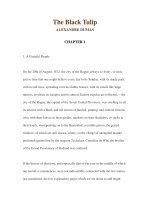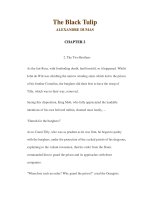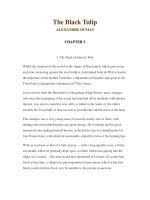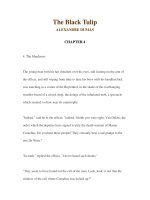The Black Scholes Model
Bạn đang xem bản rút gọn của tài liệu. Xem và tải ngay bản đầy đủ của tài liệu tại đây (191.64 KB, 12 trang )
5
The Black Scholes Model
5.1 INTRODUCTION
In the last chapter, two approaches were suggested for finding the price of an option:
r
Use risk neutrality to set growth rates (returns) equal to the interest rate and with these
substitutions, work out the expected value of the payoff. The present value of this amount
equals the fair value of the option today.
r
Solve the Black Scholes equation subject to the appropriate boundary conditions.
Either of these methods can be used to derive the Black Scholes model for the prices of
European call and put options, which is the most famous and widely used option model. It
consists of a simple formula giving the value of the option as a function of a few parameters;
this is called a “closed form solution”. Normally, models do not come in such a convenient
form, but consist of a set of procedures which are applied in order to get a numerical value for
the price of an option; these are the “numerical methods” described in Part 2 of this book.
In the analysis of the previous chapters, a number of restrictive assumptions have been made.
They are referred to collectively as the Black Scholes assumptions or a description of the Black
Scholes world:
(A) Volatility is constant.
(B) Cash is borrowed or deposited at the same constant rate of interest.
(C) There is no buy/sell spread or sales commission.
(D) It is possible to short stock without charge.
(E) Markets are continuous, so there is always a quote available.
(F) Markets exist for any quantity of stock, including fractions of stock.
(G) Markets are completely liquid, so we get instant execution, in any size, at the quoted price.
5.2 DERIVATION OF MODEL FROM EXPECTED VALUES
(i) Risk neutrality tells us that the value at time t = 0 of a call option maturing at time T = 0is
given by
C
0
= e
−rT
E[C
T
]
risk neutral
= e
−rT
E[max[(S
T
− X ), 0]]
risk neutral
For notional simplicity, the risk-neutral suffix will be dropped but it must always be remembered
that we are dealing with pseudo-probabilities and pseudo-expectations.
The value of the option is zero if it expires out-of-the-money (S
T
< X), so the expression
for the value of the call option at t = 0 may be written
C
0
= e
−rT
E
[
S
T
− X : S
T
> X
]
(ii) In order to obtain the expected value we need to multiply the payoff by a probability dis-
tribution and integrate over S
T
. However, it is mathematically much simpler to transform
5 The Black Scholes Model
variables: equation (3.7) states that S
T
= S
0
e
mT+σ
√
Tz
T
where m = µ −
1
2
σ
2
and z
T
is a stan-
dard normal variate; in a risk-neutral world with dividends, m = (r − q) −
1
2
σ
2
. The mechan-
ical details of how to evaluate the conditional expectations are given in Appendix A.1(v) The
result is
C
0
= e
−rT
S
0
e
(r−q)T
N[σ
√
T − Z
X
] − X N[−Z
X
]
where Z
X
= (ln(X/S
0
) − mT)/σ
√
T . This result is more usually written as
C
0
= e
−rT
{F
0T
N[d
1
] − X N[d
2
]}
d
2
= d
1
− σ
√
T
d
1
=
ln(F
0T
/ X
+
1
2
σ
2
T
/σ
√
T =
ln S
0
/ X + (r − q)T +
1
2
σ
2
T
/σ
√
T (5.1)
where F
0T
is the forward price.
(iii) Note that for constant X,E[X : S
T
> X] = E[X | S
T
> X]E[S
T
> X] = X P[S
T
> X]. It is
therefore sometimes stated that the factor N[d
2
] is the probability that S
T
> X, i.e. that the
option will be exercised. But remember that risk neutrality has led to the substitution µ → r.
Therefore P[S
T
> X] is a pseudo-probability. The true probability that S
T
> X is N[d
2
], but
with r replaced by µ.
(iv) General Black Scholes Formula for Put or Call: Recall the put–call parity relationship of
Section 2.2(i):
F
0T
+ P
0
e
rT
= X + C
0
e
rT
Substitute from the Black Scholes expression for C
0
:
P
0
e
rT
= X{1 − N[d
2
]}−F
0T
{1 − N[d
1
]}
From equation (A1.4), N[d] + N[−d] = 1, so that
P
0
= e
−rT
{X N[−d
2
] − F
0T
N[−d
1
]}
The Black Scholes formulas for European put and call options can be combined as
f
0
= e
−rT
φ{F
0T
N[φd
1
] − X N[φd
2
]} (5.2)
where φ =+1 for a call option and φ =−1 for a put.
(v) In manipulating these formulas, we often need an option price at time t.Clearly, this is obtained
from equation (5.2) merely by making the substitutions f
0
→ f
t
; S
0
→ S
t
; F
0T
→ F
tT
;
T → T − t.
5.3 SOLUTIONS OF THE BLACK SCHOLES EQUATION
It has been shown that the same arbitrage reasoning leads both to the risk-neutral stock price
distribution (from which we derived the Black Scholes model), and to the Black Scholes
equation. The two approaches should therefore lead to the same final conclusions: now comes
the acid test.
52
5.4 GREEKS FOR THE BLACK SCHOLES MODEL
(i) Stated formally, we seek a solution C(S
0
, T ) of the equation
∂C
0
∂T
= (r − q)S
0
∂C
0
∂ S
0
+
1
2
σ
2
S
2
0
∂
2
C
0
∂ S
2
0
− rC
0
subject to the initial and boundary conditions
r
C(S
0
, 0) = max[0, S
0
− X ]
r
lim
S
0
→0
C(S
0
, T ) → 0
r
lim
S
0
→∞
C(S
0
, T ) → S
0
e
−qT
− X e
−rT
(ii) Let us now make the following transformations, suggested by equation (A4.5) in the Appendix:
C
0
= e
−rT
/
1
2
σ
2
e
−kx−k
2
T
v(x, T
); x = ln S
0
; T
=
1
2
σ
2
T ; k =
r − q −
1
2
σ
2
σ
2
Substituting in the previous equation and doing the algebra reduces the problem to a solution
of the equation
∂v
∂T
=
∂
2
v
∂x
2
subject to initial and boundary conditions
r
v(x, 0) = max[0, e
(k+1)x
− X e
kx
]
r
lim
x→−∞
v(x, T
) → 0
r
lim
x→∞
v(x, T
) → e
(k+1)x+(k+1)
2
T
− X e
kx+k
2
T
(iii) The solution of this problem is demonstrated in the Appendix: using Fourier transforms in
equation (A6.5) or using Green’s functions in equation (A7.8) we can write
v(x, T
) =
+∞
−∞
e
kx
max[0, e
x
− X ]
1
2
√
π T
e
−
(y−x)
2
4T
dy
Without detailing every tedious step, the integral is performed as follows:
r
Get rid of the awkward “max” function in the integral, setting the lower limit of integration
y = ln X.
r
Change the variable of integration
(y−x )
2
4T
→ z.
r
Use the standard integral results of Appendix A.1(v).
r
Substitute back for x, T
and k .
If the reader cares to check all this he will retrieve equation (5.1), the Black Scholes formula.
5.4 GREEKS FOR THE BLACK SCHOLES MODEL
(i) Some Useful Differentials: The Black Scholes model gives specific analytical formulas for
the prices of European put and call options. It is therefore possible to give formulas for the
Greeks simply by differentiation. The starting point is the Black Scholes model, but before
slogging away at the differentials, we note a couple of general results which much simplify
the computations.
53
5 The Black Scholes Model
(A) From equation (A1.2) we have
∂ N[φd]
∂θ
=
∂ N[φd]
∂(φd)
∂(φd)
∂θ
= φn(d)
∂d
∂θ
where φ can only take values ±1 and is independent of θ , and n(d) =
1
√
2π
e
−
1
2
d
2
.
(B) From the definitions of d
1
and d
2
given in equation (5.1), it follows that
d
2
− d
1
=−σ
√
T and d
2
+ d
1
=
2
σ
√
T
ln
S
0
e
−qT
X e
−rT
so that
d
2
2
− d
2
1
= (d
2
− d
1
)(d
2
+ d
1
) =−2ln
S
0
e
−qT
X e
−rT
Substituting this into the explicit expression for n(d
2
) in (A) above gives
n(d
2
) =
1
√
2π
e
−
1
2
d
2
1
+ln
S
0
e
−qT
X e
−rT
or S
0
e
−qT
n(d
1
) = X e
−rT
n(d
2
)
(C) Differentiating the relationship d
1
− d
2
= σ
√
T gives
∂d
1
∂ S
0
−
∂d
2
∂ S
0
= 0
∂d
1
∂r
−
∂d
2
∂r
= 0
∂d
1
∂T
−
∂d
2
∂T
=
σ
2
√
T
∂d
1
∂σ
−
∂d
2
∂σ
=
√
T
(D) Differentiating the explicit expression for d
1
with respect to S
0
gives
∂d
1
∂ S
0
=
1
S
0
σ
√
T
The Greeks can now be obtained by differentiating equation (5.2):
f
0
= φS
0
e
−qT
N[φd
1
] − φ X e
−rT
N[φd
2
]
d
1
=
1
σ
√
T
ln
S
0
e
−qT
X e
−rT
+
1
2
σ
√
T ; d
2
=
1
σ
√
T
ln
S
0
e
−qT
X e
−rT
−
1
2
σ
√
T
(ii) Delta:
=
∂ f
0
∂ S
0
= φ e
−qT
N[φd
1
] + φ S
0
e
−qT
n(d
1
)
∂d
1
∂ S
0
− φ X e
−rT
n(d
2
)
∂d
2
∂ S
0
Using (B) and (C) above gives
= φ e
−qT
N[φd
1
] (5.3)
(iii) Gamma:
=
∂
∂ S
0
= φ
2
e
−qT
n(d
1
)
∂d
1
∂ S
0
and
∂d
1
∂ S
0
=
1
Sσ
√
T
54
5.4 GREEKS FOR THE BLACK SCHOLES MODEL
so that
=
n(d
1
)
Sσ
√
T
e
−qT
Note that this is independent of φ so that is the same for a put or a call option.
(iv) Theta: The differential of the Black Scholes formula with respect to T would measure the rate
of increase of the value of an option as its time to maturity increases; but theta is the rate of
increase in value as time passes, i.e. as the maturity of the option decreases. Recalling the
conventions described in Section 1.1(v):
=
∂ f
0
∂t
=−
∂ f
0
∂T
= φqS
0
e
−qT
N[φd
1
] − φrXe
−rT
N[φd
2
]
−S
0
e
−qT
n(d
1
)
∂d
1
∂T
+ X e
−rT
n(d
2
)
∂d
2
∂T
Once again using (B) and (C) above gives
= φqS
0
e
−qT
N[φd
1
] − φrXe
−rT
N[φd
2
] − S
0
e
−qT
n(d
1
)
σ
2
√
T
(v) Vega:
=
∂ f
0
∂σ
= S
0
e
−qT
n(d
1
)
∂d
1
∂σ
− X e
−rT
n(d
2
)
∂d
2
∂σ
As before this can be simplified to
= S
0
e
−qT
n(d
1
)
√
T = X e
−rT
n(d
2
)
√
T (5.4)
No! The equals sign is not a typo. A direct comparison between this and the expression for
gamma gives
= S
2
σ T
(vi) Rho:
ρ =
∂ f
0
∂r
= S
0
e
−qT
n(d
1
)
∂d
1
∂r
− X e
−rT
n(d
2
)
∂d
2
∂r
+ φTXe
−rT
N[φd
2
]
ρ = φTXe
−rT
N[φd
2
]
(vii) The specific functional form of the Black Scholes formula leads to a very simple expression
for . The value of a call option can be written
C
0
={e
−qT
N[d
1
]}S
0
−{X e
−rT
N[d
2
]}
= S
0
− B
0
where the first line is the Black Scholes formula and the second line represents a replicating
portfolio. The model can therefore be interpreted as the recipe for replicating a call: buy
e
−qT
N[d
1
] units of stock and borrow cash of X e
−rT
N[d
2
].
(viii) Approximate Option Values: The relative complexity of the Black Scholes model means that
it is quite hard to make a quick intuitive guess at the value of an option. However, practitioners
often use the formula 0.4 × σ
√
T % as the price of an at-the-money-forward option, i.e. one
where the strike price equals the forward price.
55









